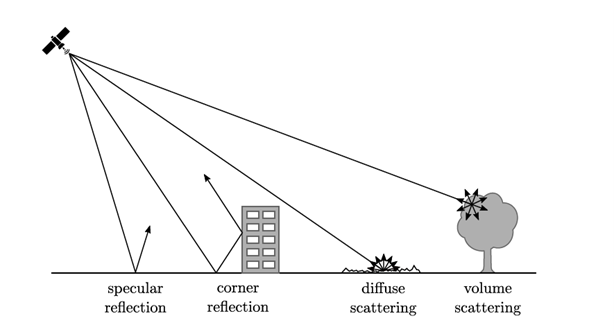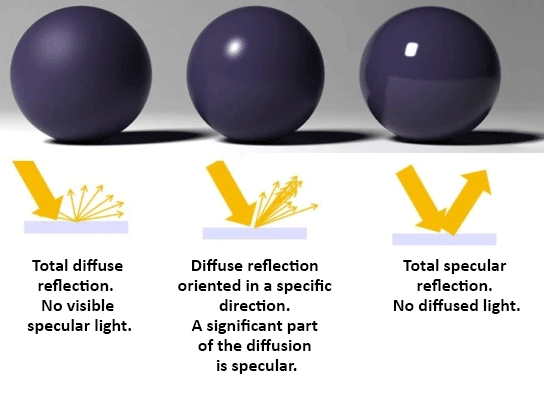I - WHAT CAN WE OBSERVE AND HOW?
3- HOW DOES RADIATION INTERACT WITH OBJECTS ON EARTH?
In passive remote sensing, sensors detect the radiation emitted by the sun and then reflected by the earth's surface. However, interactions with the atmosphere and objects on the earth's surface change the characteristics of the radiation before it reaches the sensor.
The particles and gases that make up the atmosphere can deflect or block incoming radiation. In the first case, we speak of diffusion because the waves are reflected several times and sent in all directions. The second case comes down to the absorption of waves by components of the atmosphere. For example, the ozone layer in the stratosphere absorbs a large portion of the UV rays that are extremely harmful to living creatures.
All incident waves, regardless of their wavelength, interact through resonance with objects of the same order of magnitude. This resonance induces a rotation or vibration of the molecules, resulting in heat emission.
In the visible domain (λ = 0.4 μm to 0.7 μm), the ‘objects’ with which the wave interacts are the electrons of the outermost electron shells of the atoms encountered. These are the so-called valence electrons that are important for chemical bonds. In the infrared (λ = 0.7 μm to 0.1 mm) there is interaction with atoms or molecules in their entirety.
In relation to microwaves (λ = 1 mm to 1 m), individual objects on earth are relatively small (e.g. leaves on trees, branches, window sills, pebbles, etc.) and therefore radar is sensitive to the roughness and structure of the surface. Whether we should consider an object or surface as ‘rough’ or ‘smooth’ in remote sensing is therefore actually relative to the wavelength.

Radiation and the atmosphere
When radiation reaches an object, it can absorb some of it and reflect some of it. In any case, the properties of the electromagnetic radiation will be changed, but the total energy is retained. The sum of the reflected, absorbed and transmitted energy is therefore always equal to the incident energy.
The reflected radiation is particularly interesting for remote sensing because it can be measured directly and tells us something about the reflecting object. Due to partial reflection of the incident sunlight, we perceive objects in different colours. However, we cannot see all the reflected light. Near and mid-infrared light, for example, which is strongly reflected by plants, is invisible to the human eye. Fortunately, the sensors we use for remote sensing can capture this.
Absorption of energy then causes warming and radiation in the form of thermal infrared. This is invisible to our eyes, but can often be felt and also detected with sensors.
The angle of incidence of the radiation and the roughness of the surface can influence the reflection. A distinction is made between diffuse reflection (on a rough surface) and specular reflection (on a smooth surface, such as a mirror).

Scattering of the radar signal. Source: Lillesand & Kiefer 2008
In specular reflection, the incoming radiation is reflected in a dominant direction, more specifically mirrored according to the angle of incidence relative to the normal vector at the point of incidence. If this radiation originates from a radar on board an aeroplane or satellite (active remote sensing), the sensor will consequently be unable to detect the transmitted signal. If, on the other hand, there is another reflective surface perpendicular to the incident surface, the reflected wave will have the same direction due to the double reflection and will be detected by the sensor at its maximum.
As the roughness of the surface increases and a wide variety of reflected waves are created, the number of different directions in which they are reflected will also increase. This is diffuse reflection.
Finally, with volume scattering, the radiation is transmitted in a medium from one component to another, resulting in multiple scattering. In nature, for example, treetops, deep dry sand and snow typically act as volume scatterers of microwave radiation.
Source: Images de synthèse
At radar wavelengths, the electrical permittivity of the object is important in addition to its roughness and local slope. This is the property of a material to store electrical energy, characterised by the dielectric constant. The lower it is, the deeper the wave can penetrate the material and the less it is reflected. Water has a high dielectric constant of approximately 80, compared to dry natural materials with a dielectric constant of 3 to 8. The intensity of the signal reflected back from the earth's surface in the direction of the sensor (the so-called backscattered signal) will therefore also be influenced by soil moisture. The wetter the soil, the higher the intensity of the backscatter. Conversely, the drier the soil or the canopy, the more the wave can penetrate the environment, the less is reflected and the weaker the backscatter.


